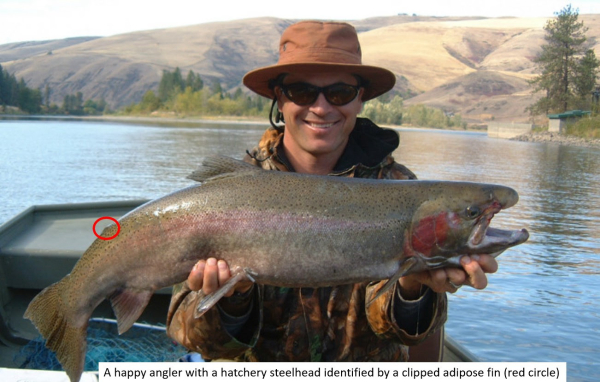
| By Braden Buttars and Joe DuPont, Idaho DFG from The Fishing Wire You set the hook and immediately your rod doubles over and there is no doubt you have hooked a big one (salmon or steelhead – you pick). Line starts peeling from your reel and you hold on for the ride. After some intense moments of thinking you may have lost the fish and some spectacular jumps, your buddy finally slips a net under the fish. After a shout for joy, what is the first thing you say? How many of you said, “Is it clipped”? I suspect many of you did seeing a clipped adipose fin distinguishes a hatchery fish from a protected wild fish telling anglers it is legal to harvest. Many of us take it for granted that hatchery fish have a clipped adipose fin, but have you ever wondered what it takes to make this happen? Joe DuPontThe Idaho fish marking program started in 1975 with a small group of people directed to tag salmon and steelhead raised in Idaho’s hatcheries. Their primary objective was to insert tiny pieces of wire, known as coded-wire tags, into the snouts of over one million salmon and steelhead. Each of these tagged fish also needed their adipose fin clipped to signify it contained a coded-wire tag. The recovery of these coded- wire tags would then help us evaluate how Idaho hatcheries contributed to fisheries in the Columbia River and ocean. Northwest Marine TechnologyIdaho’s fish-marking program has changed dramatically since 1975. In 1984 the fish-marking program was directed to remove the adipose fin from more than 9 million Idaho hatchery steelhead so that anglers could distinguish hatchery fish from wild fish. This required a small army of people equipped with scissors working 40 hours a week for about three months to accomplish this task. Once, to meet a deadline at Dworshak Hatchery in 1987, over 130 different temporaries were hired to keep four marking trailers operating 16 hours a day to remove the adipose fins from almost 3 million steelhead in 10 days. By the early 1990s, almost all hatchery Chinook Salmon released in Idaho were fin clipped, and hundreds of thousands of PIT tags were being injected into smolts to help answer specific research questions and provide managers real-time data to better manage fisheries. It got to the point that Idaho’s fish marking program could not accomplish this alone and Federal Agencies also began to help. Despite this, Idaho’s fish marking program clipped and tagged approximately 11 million juvenile salmon and steelhead each year. All this work was done by hand requiring a dedicated force of temporarily. In 2002 Idaho began to automate the fish marking program allowing more fish to be processed with less error. The first AutoFish Trailer was purchased in 2002. In 2004 Idaho purchased two additional AutoFish Trailers and two more were purchased in 2014. With this new technology, the Idaho Fish-Marking Program is now able to processes around 17 million salmon and steelhead from 9 Idaho hatcheries that contribute to major salmon and steelhead fisheries throughout Idaho and the Pacific Northwest. Now that Idaho’s fish marking program has been using automated trailers for 18 years, they have refined this process to where most fish never need to be touched by a person. To make this happen, the automated trailers are parked right next to the raceways where the fish are being raised. This allows the fish to be directly pumped from the raceway, run through the marking trailers where their adipose fins are clipped and coded-wire tags are injected, and then discharged back to a nearby raceway with no direct human contact. The first time you step into one of these marking trailer is seems more like you are entering a high tech computer facility than a place where fish are being marked. These automated trailers have the ability to sort individual fish by size using video imaging so that the right size fish goes into the right machine. This is required because each machine is programmed precisely to handle certain sized fish. Once a fish is sorted into the right machine, it gently clamps the fish in place and in a fraction of a second it can insert a coded-wire tag, clip its adipose fin, and confirm that the adipose fin was removed adequately. All this is accomplished without removing the fish from the water or using any type of anesthetic which reduces stress on the fish. For more detail on how this process click on this video link fish marking video. Roger Phillips Because of this technology, we now have an accurate count of all clipped hatchery fish at each hatchery and how these fish were marked or tagged. The application of these technologies allows fisheries managers to evaluate, track, and manage fish to provide for the protection and recovery of wild fish, while maximizing commercial and sport use of hatchery fish. In case you were wondering, in 2019, Idaho’s Fish-Marking Program was responsible for marking 16.35 million juvenile fish (10.7 million salmon and 5.65 million steelhead) as well as manually inserting 398,443 PIT tags across 9 anadromous fish hatcheries managed by the Idaho Department of Fish and Game. |